Redefining B2B sales: AI’s impact on prospecting, selling and admin
The current state of B2B sales, where AI will have the most impact, and the startups making it happen.
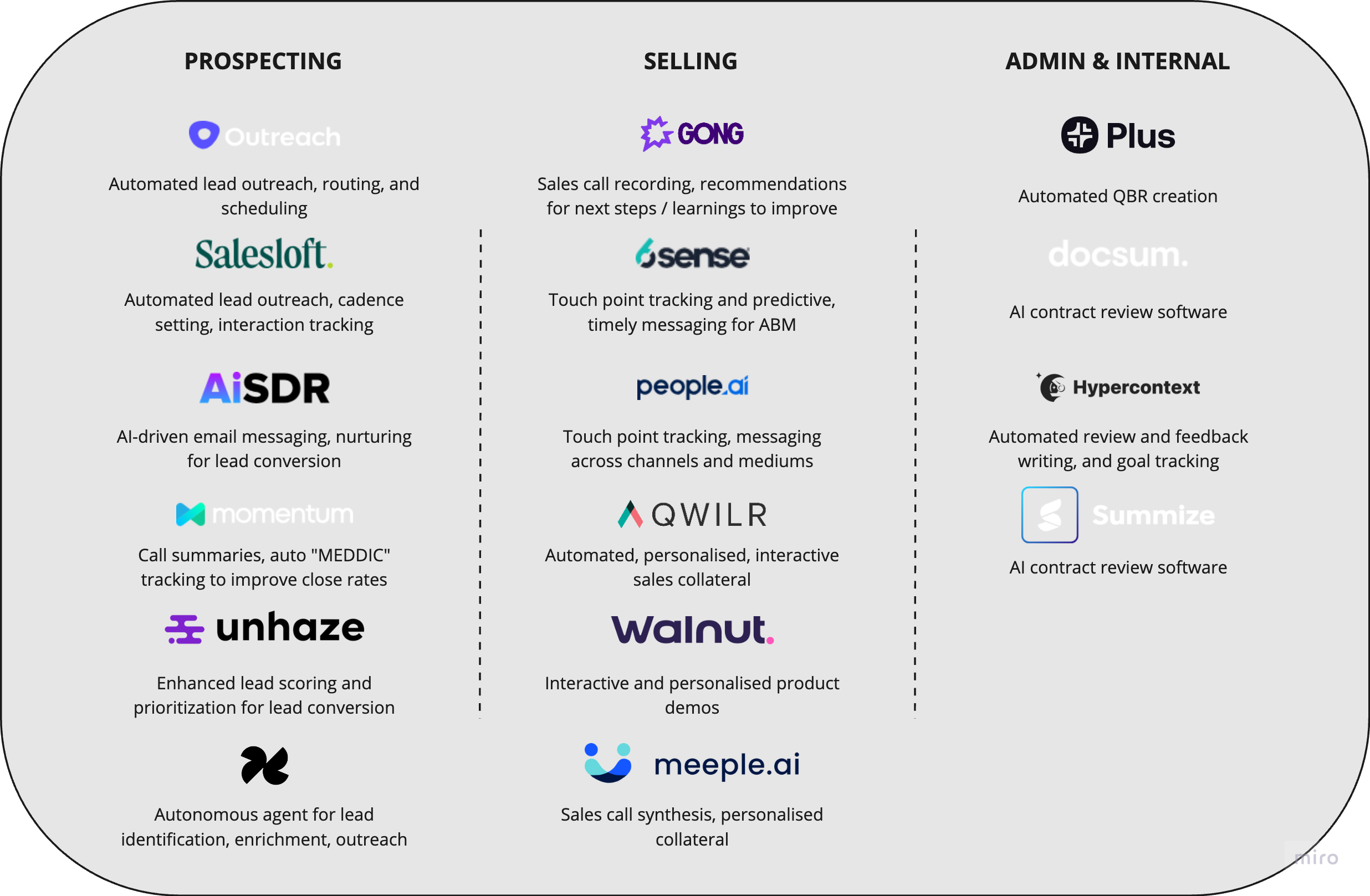
Thanks to our MBA intern Jack Heller, who co-authored this piece.
The job of a B2B SaaS company’s Chief Revenue Officer – all things sales, support, and retention – has long been, and still is, human-driven and unnecessarily cumbersome. Despite typically being a company’s most resource-intensive function and critical to growth, large portions of the workflow remain redundant, manual and inefficient. We believe AI will increasingly automate this function, making it cheaper and more effective over the next five to 10 years.
Let’s take a look at the current state of B2B sales, where AI will be most impactful, some of the startups making it happen – and what we think will give their founders and products success.
TL;DR
- B2B sales is highly manual, human-driven, and inefficient. Using AI can streamline processes, saving time and resources (reducing costs over the long term), while improving close rates and leads (boosting revenue).
- Automating the outbound, or prospecting, function is the lowest hanging fruit – and most crowded with new startups.
- However, initial “hook” use cases, like AI-personalised emails and responses, and AI lead scoring, are not quickly trusted by sales leaders. Proven ROI (increased win rates and meeting book rates) and a roadmap to fully replace the SDR/BDR are crucial to durable success in this space.
- The right wedge may be to focus on better lead scoring versus email drafting. AI personalised messaging is already highly competitive, met with scepticism, and has more downside risk (burning a strong lead vs missing better leads they likely would have missed anyway).
- Other big opportunities exist where it may be harder to build a strong product, but where there are no strong, truly automated and scaled solutions today, including: product demo setup and customisation, personalised collateral, prospect research, and live in-call coaching.
- Market feedback suggests that admin tasks still occupy 25-50% of a salesperson’s time. There is a need for products that 1) auto-populate deal review templates and forms for meetings, 2) provide closed feedback loops for leaders to coach and track KPIs, and 3) automate contract processes near the close of deals.
- The winners in this space will develop more than just a basic "GPT wrapper", and instead create tools that integrate seamlessly into existing workflows, continuously improve through internal data training, and explore creative data sources to enhance decision-making. A founding team with commercial experience in the problem area, strong technical talent in LLMs and NLP, and an ROI-focused mindset, is equally critical.
The status quo of B2B sales
Consider from first principles where the money is spent today within the sales org – this can tell us where resources are not optimally allocated.
Using David Sacks’s headcount guidance on a typical Series B/C SaaS startup, industry salary benchmarks (see bottom row), and inputs from numerous salespeople interviews (the table %s), we can impute resource $ allocation across activities for an “average” venture-backed SaaS company.
Prospecting, actual selling, and admin/internal work are the most costly:
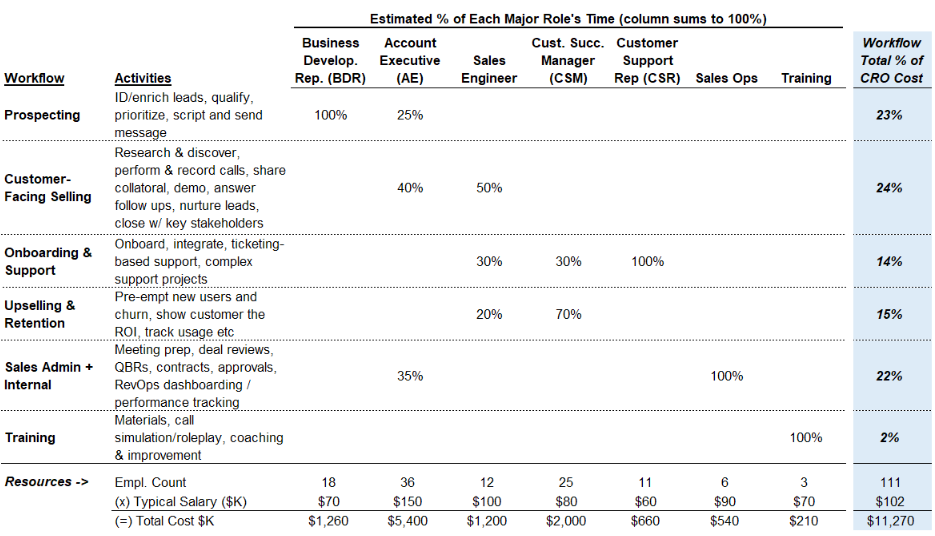
These major workflows can then be broken down by the main activities throughout a sales lead’s journey – from initial prospecting, to close, then to onboarding and retention. This flow is simplified, but it conveys how complex and multifaceted the B2B sales cycle can be:
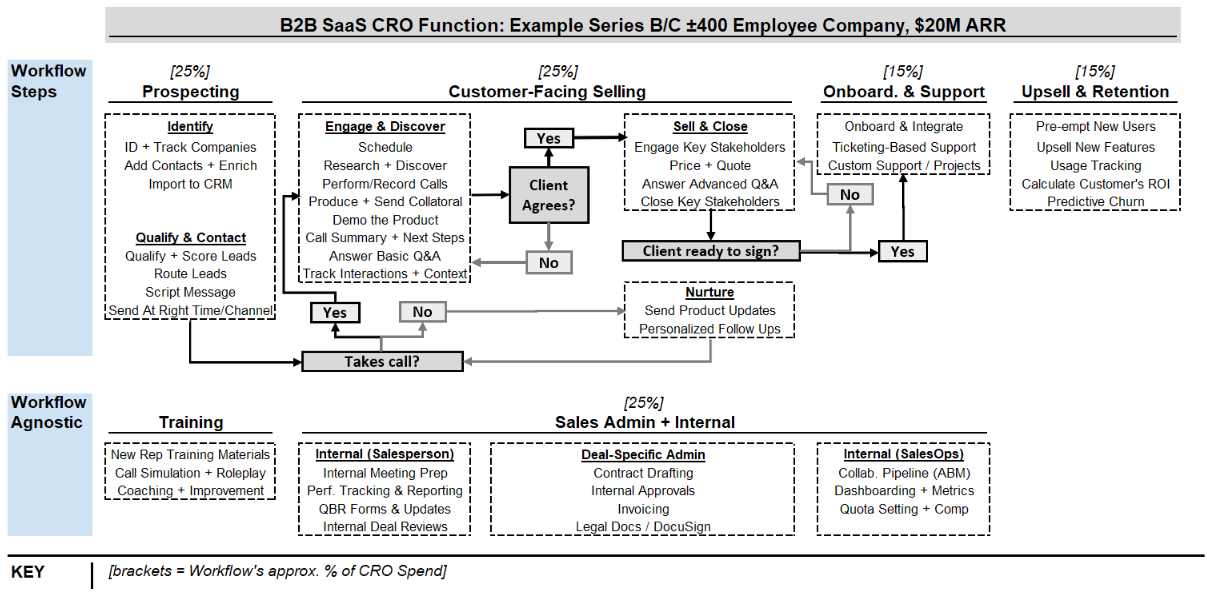
Where AI can make a difference
Many of these activities are on their way to being automated, or have been for a while. Think Gong for recording and transcribing sales calls, and Outreach for automating basic outbound emails.
Recent progress in commercialised AI can not only automate these processes, but make them more effective, particularly where they are: 1) possible to codify, 2) repeatable, 3) data driven, and 4) not bespoke, high-stake customer interactions.
Now let’s re-imagine these workflows, where green = “could be automated/improved with AI”:
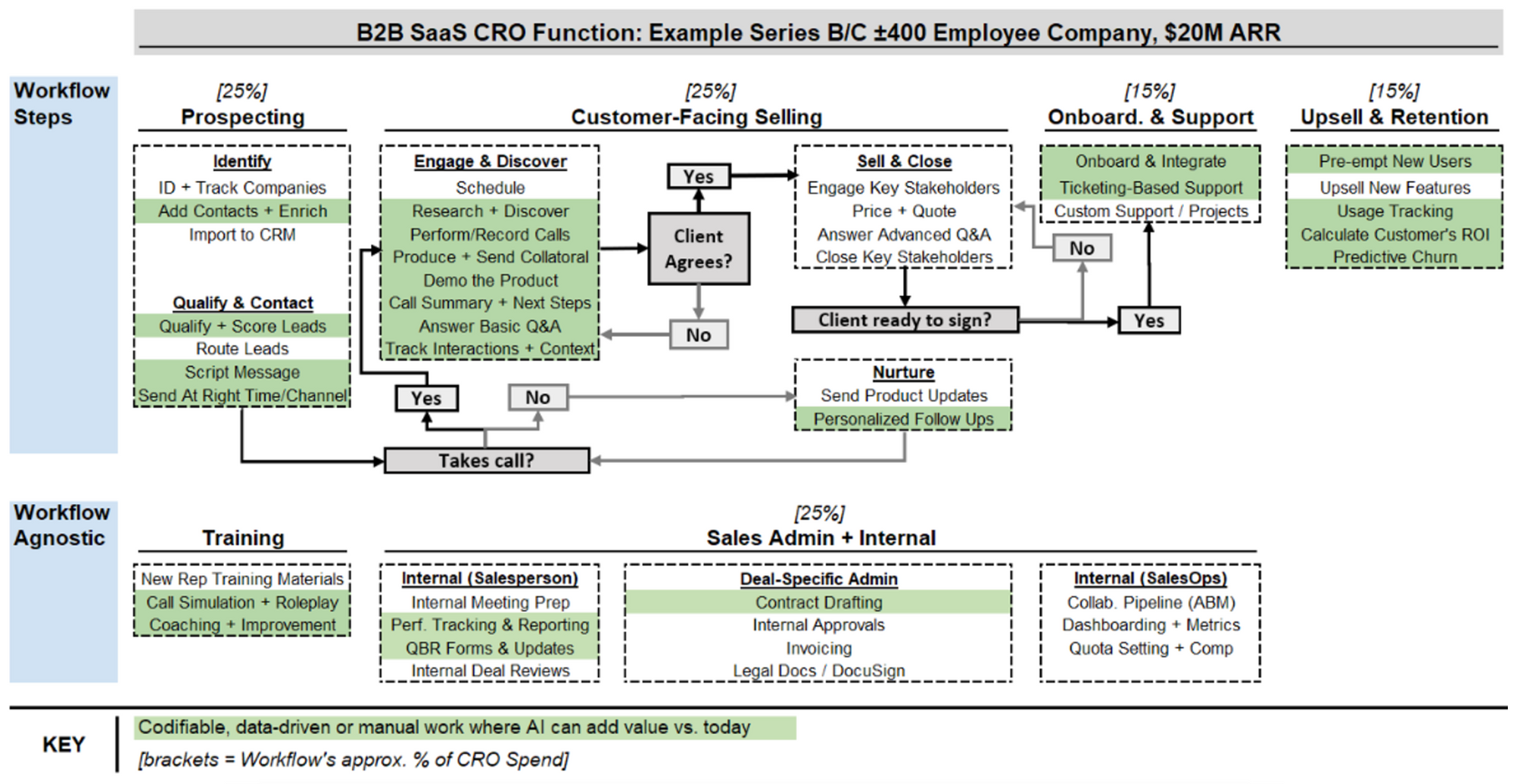
Let's break down the three most costly parts of the workflow from above: prospecting, selling, and sales admin & internal.
For each, we’ll look at: 1) how current workflows would change in a totally AI-equipped world, 2) example startups in the space that are building AI-enabled solutions, and 3) what successful B2B tooling companies have historically done right in these areas.
Prospecting
From interviews we ran with COOs, sales leads, account managers, and growth ops managers, the business development representative (BDR) and sales development representative (SDR) are the most manual, least efficient functions. Is a world with a totally automated BDR and SDR function possible?
‘We can’t trust our BDRs to find good new accounts; they’re right out of college, and often skip the LinkedIn and just go right to spamming on Outreach’
– Sales Lead at Series A SaaS startup
‘Sales leaders are thinking about how we can create 10x SDRs with the good ones, and eliminate the ones that can’t become that with AI-driven tooling’
– B2B CRO consultant (former YC founder)
How AI can transform workflows
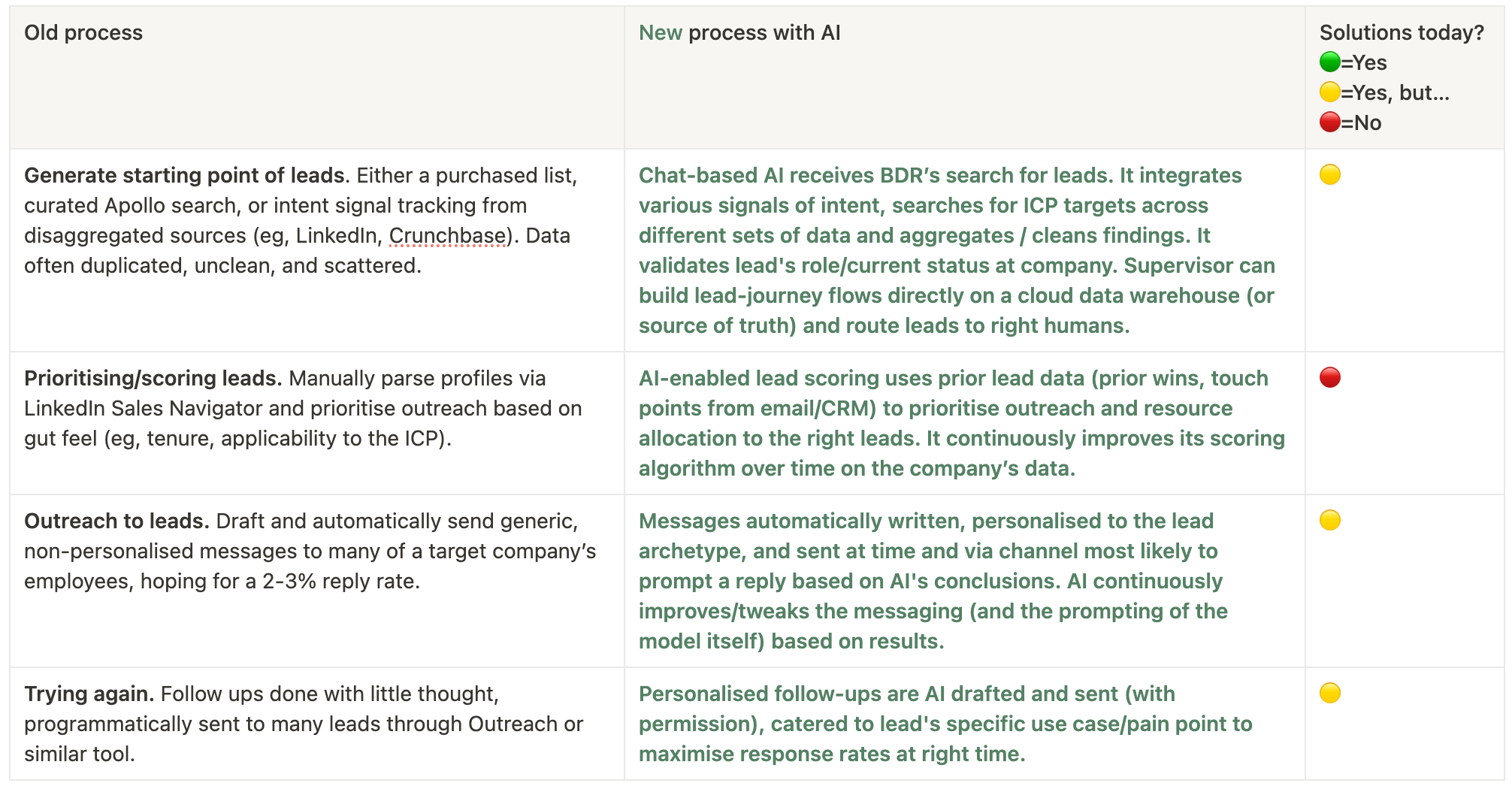
If we are on the road to automating BDRs and SDRs, should the initial focus be on better lead scoring or improved outreach?
The majority of the feedback from our interviews sees outreach as the biggest time saver in the near term – if it works. The problem is that there is significant scepticism among sales leaders that AI can be as good as the human touch. There are also many startups pursuing this angle, which makes it hard to differentiate.
Alternatively, truly AI-driven lead scoring and identification could deliver more value, despite being more challenging to build. This could particularly help businesses still defining their ideal customer profile (ICP), selling into industries where decision makers are harder to identify, or lacking data sources that indicate purchase intent.
Lead scoring also presents a lower risk. If I can help identify more leads with higher likelihood to purchase, and make them more likely to respond to the same average email, that’s great. The downside is limited; it's unlikely to result in outcomes worse than those with existing tooling. For automated outreach, the risk is much higher: hallucination or a poor message could waste a very qualified lead.
Success story
Outreach. Founded in 2011 as GroupTalent, a hiring platform, the team pivoted to an automated lead outreach, routing, and scheduling tool for sales reps in 2013 when an internal outreach tool they developed to boost their lead meetings excited their customers more than their original platform.
They became laser focused on sales rep problems, ensuring product-market fit, built around a high ROI use case of improving reply rates to cold emails. And it paid off. Their product hit a 40% reply rate to cold emails, helping them to secure funding and propel them to a valuation of $4.4bn in 2021.
Selling
Getting a prospect from first call to close can be reimagined with AI. Account executives (AEs) want to spend more time in high-value selling conversations, where a personalised touch and reactivity will remain critical. Much of the other "stuff" they have to do along the way can be done with AI – with more speed, continuous improvement, personalisation, while reducing tool fatigue.
Feedback from our interviews with AEs and VPs of growth suggested that some of this tooling already exists, but it is either too cumbersome, not truly automated, or ineffective.
‘AEs will get a lead from a BDR and be told the prospect wants to chat tomorrow – but the AE needs to push it back because they need 1-2 days to really get educated about the prospect.’
– VP of Growth at Series B SaaS startup
‘Follow ups from demos are sneaky, time consuming, and manual. They may say, “this was interesting, send us more examples/documentation/case studies”, but this stuff is tribal knowledge; it’s not housed in one place, and is not personalised.’
– Mid-Market AE for large B2B SaaS company
How AI can transform workflows
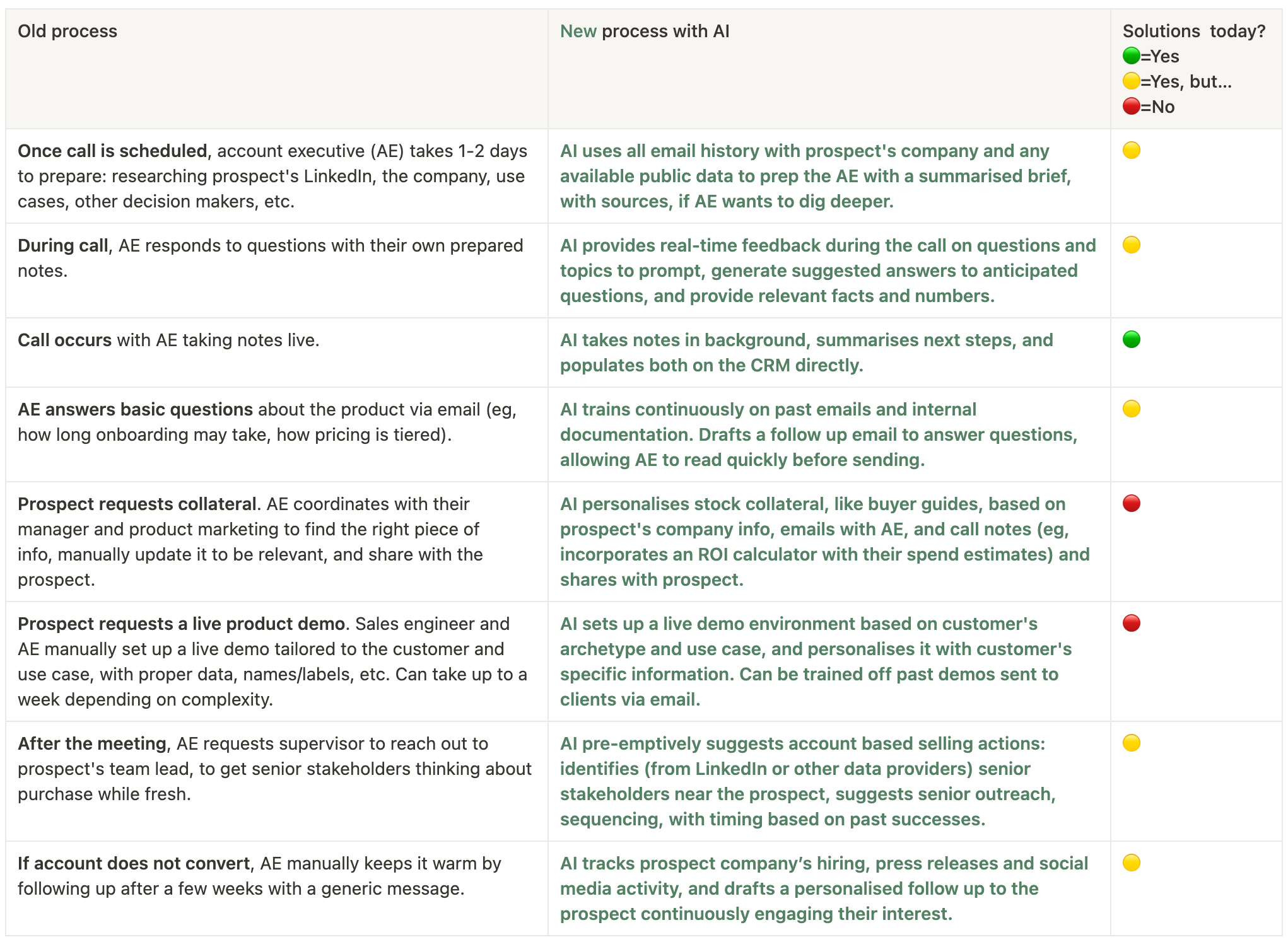
Success story
Gong. Founded in 2015, the company quickly emerged as a leading revenue intelligence service, growing to a $7bn valuation and $100m+ revenue by 2021. It records B2B sales lead conversations and recommends next steps and tips for future calls using AI.
Their success was driven by three primary factors.
The founding team had lived the problem area. Founder and CEO Amit Bendov, drawing on his experience as CMO of Panaya, saw an opportunity to capture and synthesise customer interactions more effectively than existing manual summaries, typically pasted into the CRM.
The team could build and ship quickly. Despite raising $6m in seed funding, they had an MVP ready after only three months and spending $1m of the $6m. They set up basic infrastructure and focused ruthlessly on the application layer, iterating from early customer feedback, quickly pushing from trial to revenue.
They acquired 12 customers via network and friends for the alpha in five months – 11 of which converted after they ended the trial, hitting $100k ARR. Within one year they reached $1m ARR, and won 400 customers in two years.
Content marketing played a large role in customer acquisition. The team’s deep understanding of B2B sales processes, coupled with the data from their own platform, enabled them to produce truly unique content that drew inbound customers. Instead of typical sales content, they used data from actual sales conversations, converting that into actionable insights.
Sales admin & internal
Internal processes and other administrative work that salespeople do surrounding the sale can’t all be eliminated (at least in the near term), but much of it can be improved with AI.
The feedback we got from our interviews suggested that prepping, populating templates for internal meetings, and closing paperwork and contracts are all areas where AI can play a role.
‘Paperwork to actually close a deal involves some automating tools, but is still very manual. You have alignment on the numbers, but I need to actually create a quote, generate an order form, send an email form or docusign, get our team to sign it…then they want to negotiate custom contract clauses, which I just have to change manually and sometimes work with our legal team.’
– Mid-Market AE for large B2B SaaS company
‘I spend way too much time on internal admin. We do big deal reviews all the time…or QBRs…AI should do a first draft. My boss should be able to get this template, click a button, and it should populate. AEs spend so much time manually copying and pasting data into their managers template for QBRs... Seems so unnecessary. It all lives in Salesforce.’
– Senior Account Manager for large B2B SaaS company
How AI can transform workflows
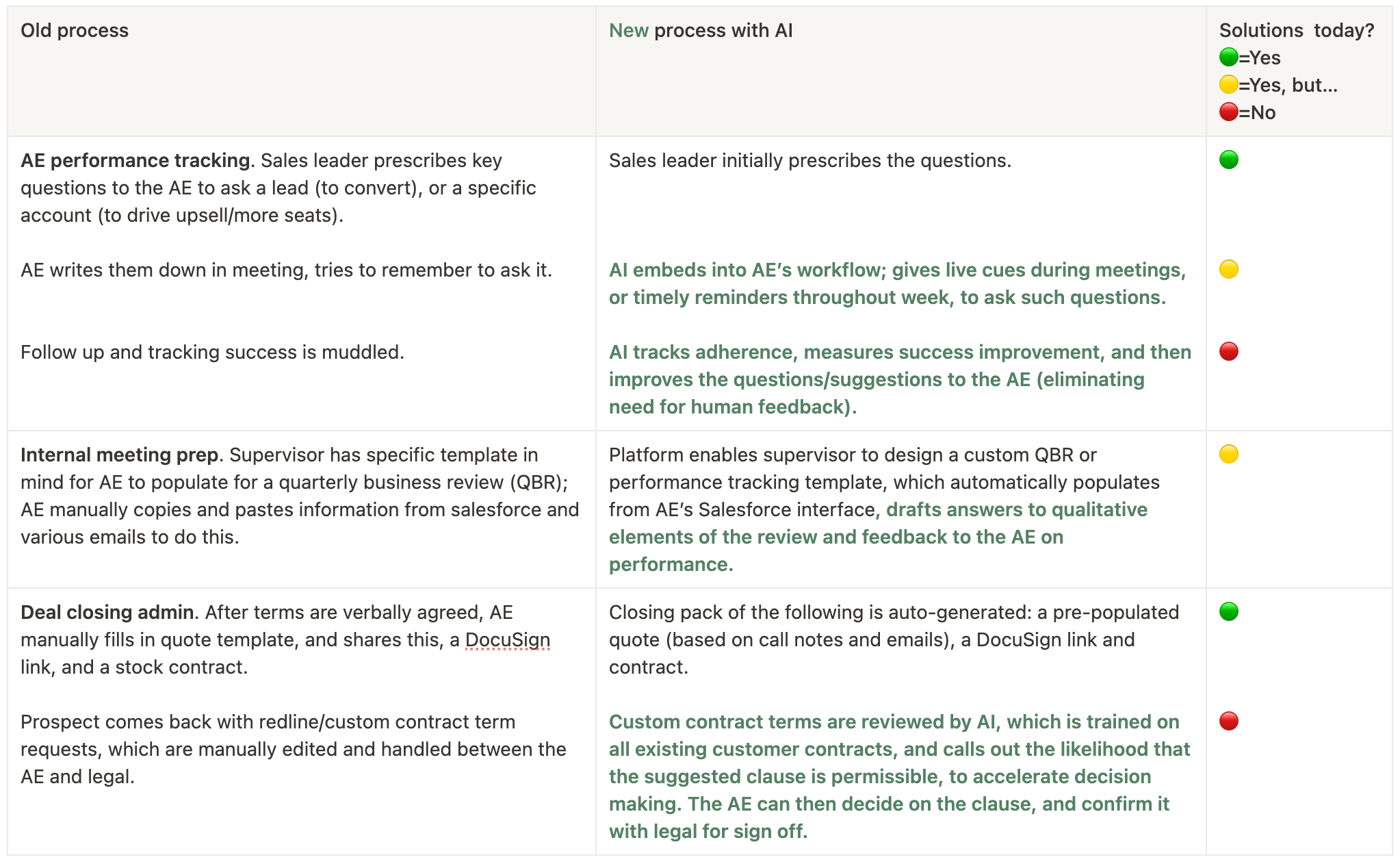
Interesting startups
Here's a non-exhaustive map of some of the exciting companies building in the space. (We've included website links to each company at the end of this piece.)

Key attributes
So what gives startups in this space the best chance of success?
On the product front:
More than just a "GPT wrapper". The winners are developing tools capable of not just providing observability or accessibility via AI, but also using proprietary data or ingrained expertise to generate better decisions.
Seamless integration into existing workflows. Be it a CRM or data warehouse, this is imperative. Time is money, particularly in sales – and in a world of thousands of sales tools, winning products need to embed well with existing processes and major foundational tools.
Continuous improvement. The best businesses will have the capability to safely and continuously train on all internal data in a closed-loop manner, refining its outputs and any underlying prompts over time.
Creative data sources and comprehensive ingestion. The best companies can differentiate by effectively synthesising all pertinent internal and external data, encompassing text, email, and social touch-points. By going beyond the often incomplete data in CRMs and exploring innovative avenues to find warm leads, a product can significantly increase meeting booking rates.
A vision not just to a BDR productivity tool, but to becoming a BDR replacement. Specifically to prospecting, products with a forward-thinking approach aiming to eventually eliminate the BDR/SDR function will more effectively land over the long term with mid-to-senior level sales leaders, who don't want to train high-turnover BDRs on new tooling every year.
Equally critical are the traits of the founding team:
Commercial experience living the problem area. Founders with prior exposure to B2B sales are better positioned to understand the problem domain, navigate existing tool complexity, and tap into a rich network of potential customers. This is particularly relevant in this market given the competitiveness and plethora of startups carving out positions in the B2B sales tools space.
Strong technical talent, with particular experience with natural language processing (NLP) and large language models (LLMs). This will enable potential for the closed-loop product elements mentioned above, as well as rapid product iteration.
An ROI-focused mindset. Finally, a laser focus on delivering tangible ROI, centring on a killer use case, and an inclination toward tool reduction and synthesis rather than more tool fatigue is essential. In a rapidly evolving and unpredictable market, teams with the agility to swiftly iterate and pinpoint the stickiest use cases, and lead with a proven, data-backed claim of ROI, will win.
If you’re building in the space, or want to know more about how you could apply these tools to your own sales workflow, get in touch!
Links to websites of mentioned companies
SalesLoft (Total funding amount: $250m). Automated sales outreach and cadence setting, interaction tracking, newer features involve AI transcription and call analysis.
Momentum.ai ($5m). Automating sales with AI. Helps teams improve pipeline management and close rates with automated MEDDIC, notifications, call summaries, and deal rooms.
11x ($2m). AI-powered autonomous digital workers for lead identification, enrichment, and outreach.
AiSDR (YC23). AI-powered SDR automation that qualifies inbound leads, creates and sends out personalised email campaigns, and corresponds with prospects to book a sales meeting.
Unhaze (YC23). AI platform for prioritising and scoring leads. The platform mines data from various sources and analyses a company's historical deals to identify impactful buying signals.
6sense ($500m). Touch point tracking and timely messaging for ABM. Predicts when accounts are ready to buy and delivers insights that salespeople use to engage salespeople at ideal moments with high-value, personalised outreach, follow-up, and touch points with other potential stakeholders.
People.ai ($200m). Touch point tracking and messaging. Tracks and logs all touch points and activities with a prospect across channels and mediums, integrates into CRMs, and recommends actions for nurturing or closing.
Walnut ($56m). Demo automation and personalisation.
Qwilr ($10m). Automated, personalised collateral. Creates engaging web-like sales collateral with interactive content, customizable branding, CRM integration, dynamic personalization, and data integration capabilities.
Meeple ai (no funding found). Synthesises sales calls and automates collateral personalization.
Plus ($8m). Automated QBR creation for customers.
Summize ($7m). AI contract review software. Improve legal operations with an automated, no-code digital contracting solution.
Hypercontext ($0.1m). Automated review and feedback writing, meeting summarising, and goal tracking for managers to team members.
Docsum (YC23). AI contract reviewer for sales teams.

